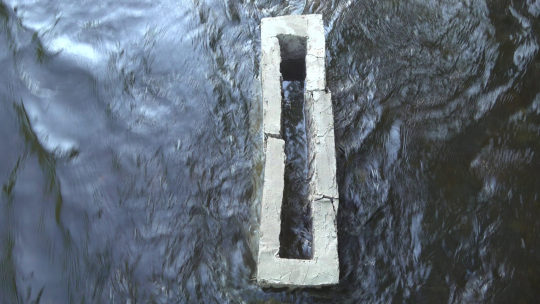
(Written as an introduction to the Anthropocene Film Residency.
Read more about the project on the Anthropocene Curriculum website.)
1
Looking down on St. Anthony Falls from the walls of the lock and dam
infrastructure, one can marvel at this feat of technical engineering.
The river runs over an artificial concrete platform creating the Falls.
The lock with its giant metal gates holds back millions of gallons of
water. It is a triumph of modern engineering and architecture, built for
commercial river traffic in pursuit of profit and progress.
The lock is now closed; its gates welded shut. Today, when standing
atop the lock and dam, one cannot help but reflect critically on its
existence as a monument to a different time, a pre-climate change past.
During a spring season that has witnessed extensive flooding up and down
the Mississippi River, one cannot help but worry about its inadequacy
and anticipate failure.
2
In its current obsolescence, the aged lock and dam infrastructure is a
monument to a dark history. Built into its hard structures is the
historical legacy of a technic for the displacement of material,
non-humans, and human communities. Its presence speaks to the violence
of forced movement and dislocation. In a material sense, a dam is
engineered to displace water, to hold it back and redirect its flow. The
concrete walls and embankments are fortified barriers for keeping
nature at bay. The dam is a military technology as well. It shares a
history with the berm, which acts as a human breakwater, a defensive
technology for the displacement and separation of groups of people.
3
Over the past six months, four artists have developed new short films inspired by our field station’s approach to Mississippi. An Anthropocene River.
They were selected because of pre-existing practices that involved a
critical envisioning of the Mississippi River and/or an assessment of
the environmental impacts of human activities on bodies of water. A
common theme in the artists’ work is an aesthetics of displacement.
Andrea Carlson’s site-specific short film, The Uncompromising Hand (2017),
revisits Spirit Island, a sacred site to multiple Indigenous
communities that was once in the Mississippi River near the current lock
and dam. Tia-Simone Gardner’s Reading the River: Yemaya and Oshun
(2018) is an experimental documentary set in port cities along the
Lower Mississippi River and reflects on Blackness in relation to
geography, architecture, and a feminist practice of unsettling how we
think and know place. Jenny Schmid’s prints, including The Last Tree Huggers (2017) and Momento Mare (2017) feature monstrous creatures who make an uneasy home in the environmental ruin of a disastrous present. John Kim’s piece, Dam, Lock, Groyne: The Temporal Architecture of the Mississippi River
(2019) is a reflection on the hard structures and earthworks found
along the entire length of the Mississippi River that displace water,
people, and non-human species. Each artist introduces their new work in
the pages that follow.
Read more about the project on the Anthropocene Curriculum website.